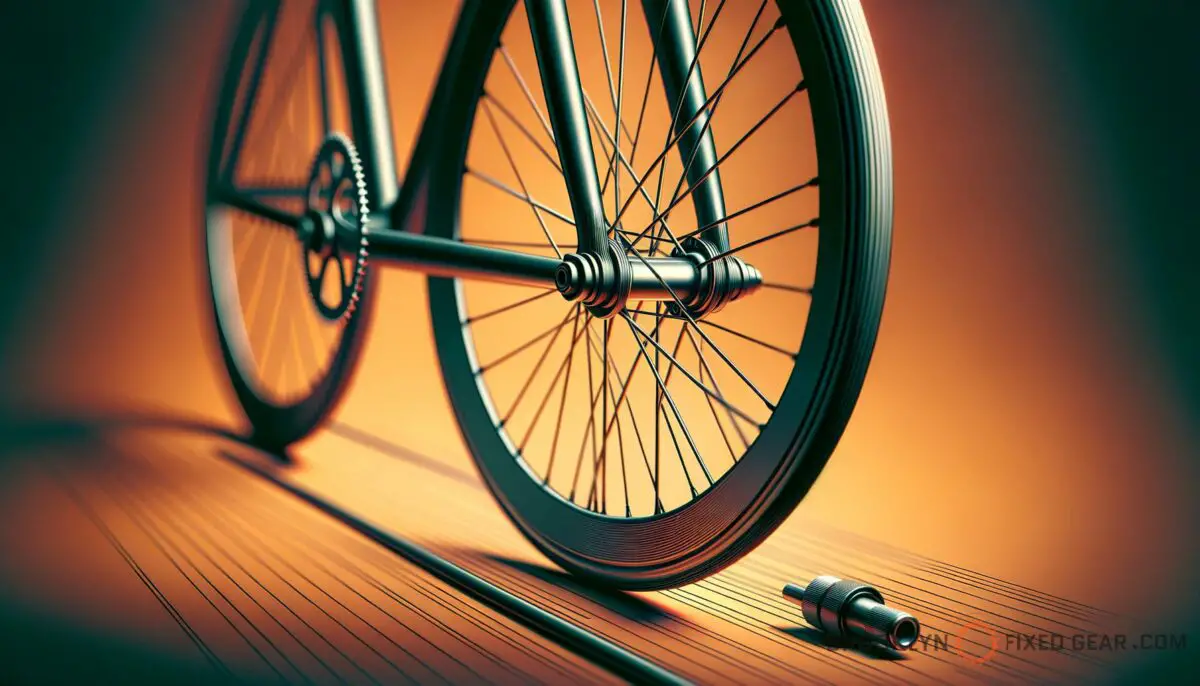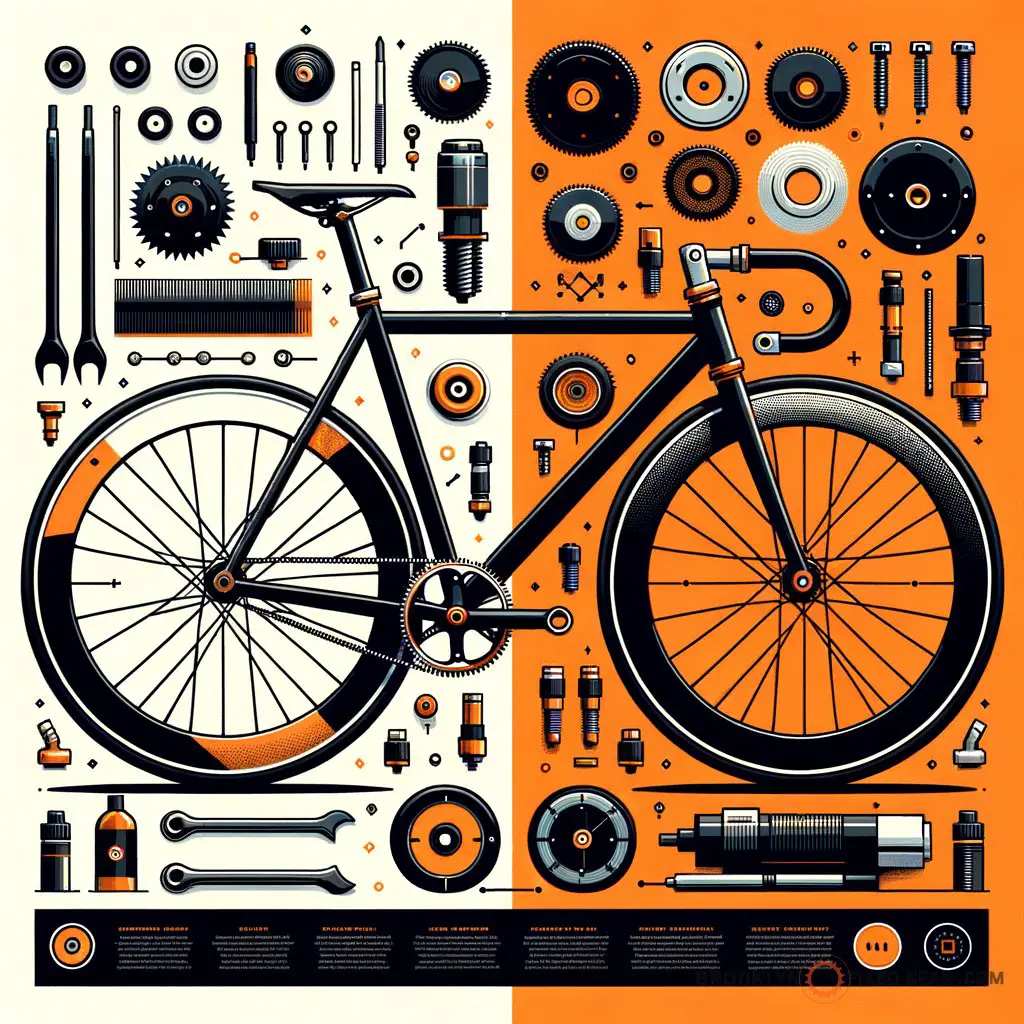Have you ever wondered about the role of a bike fork on your fixie? Let’s dive into what exactly a bike fork is and why it’s such a key component of your fixie ride. You’ll learn why this part isn’t just another piece of metal but a critical aspect of your cycling experience on the streets or the track.
Key takeaways
- A bike fork influences control, handling, and the feel of your fixie.
- Maintenance is crucial for both safety and performance.
- Customizing your fork can enhance your riding experience.
What is a bike fork on a fixie?
When you’re tearing through the streets or mastering the velodrome, the bike fork is your best pal. It’s that two-pronged piece connecting your front wheel to the frame of your track bike. With no fancy suspension or gears to worry about, a fork on a fixie is all about simplicity and efficiency.

Strong yet lightweight materials like steel or carbon fiber make up most forks, ensuring your ride is both sturdy and swift.
Here’s a snapshot of what the fork does for you:
- It holds the front wheel in place, allowing for precise control and handling.
- Absorbs some road vibration, giving you a smoother ride.
- Affects the overall geometry and performance of your bike, leading to that snappy responsiveness fixie riders love.
Its form is as streamlined as your pedaling with a design that complements the sleek frame of a fixed-gear bike. You won’t find any place for complex mechanisms here—it’s just you, the track, and a fork that effectively translates your input into motion. To pick the right fork for your ride, remember it’s all about the material, weight, and how it matches your riding style.
Check out the finest options for fixie bikes to get your setup dialed in.
Let’s real talk—bike forks might not get the same hype as a fresh set of rims or those chic drop bars, but trust me, they are crucial. From personal experience, cycling without a solid fork is like sprinting with shoes that don’t fit. You might get by, but it won’t feel right.
Now, I’m no engineer, but I know a shaky fork can throw off your entire ride—it’s like that one scene in “Breaking Away” where the protagonist’s bike malfunctions during a crucial moment, showing just how vital each component is.
So, trust your gut when it feels off, and maybe share a word with the savvy staff at your local bike shop. They usually have tales of forks that have seen better days but kept a rider safe till the last stretch. Remember, the heart of a fixie is its simplicity, and the fork is a big part of that zen.
State Bicycle Co. Black Label 6061

State Bicycle Co. Black Label 6061
Importance of the bike fork on a fixie
A bike fork might not be the first thing you notice on a fixie, but it’s arguably the most crucial part for steering and control. It connects the rider to the road and influences how the bike handles. High-quality forks use materials that balance strength and weight, like carbon fiber or chromoly steel.
For more on picking the right bike components, take a peek at common mistakes made when building a fixie.
What materials are used for fixie forks?
The materials chosen for a bike fork affect not just the weight but how the bike feels on the road. Carbon fiber forks are kings of the road for their blend of lightness and stiffness, leading to precise handling. Chromoly steel is another popular choice; it’s a bit heavier but absorbs road vibrations like a champ.

How does a fork affect bike handling?
The angle and length of the fork determine how your fixie handles. A steeper angle can make your bike feel more responsive, perfect for track racing or fast city rides. On the flip side, unless you’re craving that crit-race feel on your commute, you might favor a slightly more relaxed fork angle.
Bold statement: Your fork’s geometry is the hidden artist of your ride’s personality.
Bike fork maintenance
Like any part of your fixie, a fork needs love too. Keeping an eye on your fork ensures not just a smooth ride but your safety. From checking for bends to cracks, it’s an area where you don’t want surprises mid-ride.
If wrenching on your bike is your jam, don’t miss the best bike multi-tools to keep everything tight and right.
How do you check your fork’s health?
Regular inspections can save a lot of issues. Look for signs of stress especially where the fork meets the frame. If you spot any unusual bending or hear creaks, it’s time for a closer look or potentially a replacement.

Tips for maintaining your fork
Keep the fork’s dropouts aligned to avoid unnatural strain on the wheel. If you’re feeling a wobble or looseness, check the headset as it can affect the fork’s performance. A clean fork is a happy fork—dirt and grime can hide small issues that turn into big ones.
Customizing your fixie’s front end
Customizing a front fork can transform your fixie experience. Whether it’s a splash of color or tweaking the rake for better handling, personalizing your fork sets your bike apart. Ready to spruce up your ride?
Head over to best fixie bike handlebars for a matching aesthetic.
Choosing the right fork for your riding style
If you’re into hairpin turns and aggressive urban cycling, a fork with a shorter rake can make your fixie feel more nimble. If long rides or commuting is more your scene, a fork with a longer rake can ensure stability and comfort.
Adding personality to your fixie
Color, decals, and even the finish—matte or glossy—can say a lot about you and your fixie. It’s not all about looks; the right fork upgrade means a ride that feels tailor-made for your style.
Leading paragraph: The table below provides a snapshot of different fork materials, their typical weight ranges, and their impact on bike handling and rider experience. This data can be a starting point when deciding on the perfect fork for your fixie.
| Material | Weight Range | Handling Characteristic | Rider Experience |
|---|---|---|---|
| Carbon Fiber | Light | Precise, responsive | Smooth, high-performance |
| Chromoly Steel | Slightly heavier | Forgiving, comfortable | Durable, versatile |
| Aluminum | Moderate | Stiff, harsher | Responsive, less forgiving |
“A bike fork might not get the same hype as a fresh set of rims or those chic drop bars, but trust me, they are crucial. From personal experience, cycling without a solid fork is like sprinting with shoes that don’t fit.”
When tuning up your fixie, it’s crucial to know the dos and don’ts to ensure you’re on the right track. Here’s a handy table that’ll keep you pedaling smoothly without any missteps.
| Do | Don’t |
|---|---|
| Check your fork for damage regularly | Ignore any signs of wear or damage |
| Make sure bolts are tight and secure | Over-tighten bolts and risk stripping threads |
| Clean your fork to spot potential issues | Let dirt accumulate and potentially hide problems |
| Consider the material in relation to your riding style | Choose a fork solely based on appearance |
To keep your fixie in prime condition, it’s not just about the don’ts; the right moves can up your cycling game and extend your ride’s lifespan.
More cycling maintenance tips
Alongside checking your fork, there’s a whole checklist to keep your wheels spinning. Here are a few extra pointers:
- Inspect your tires for proper inflation and wear – they’re the only part that touches the ground after all.
- Keep your chain clean and well-lubricated for a silent and smooth ride.
- Stay on top of brake maintenance – sure, we’re all about that fixed-gear life, but stopping on a dime is crucial.
- If you’ve got a flip-flop hub, check both the fixed and freewheel for proper function.
- Don’t forget about ergonomics in cycling – a comfortable rider is a happy rider. Find out all about it at what is ergonomics in cycling.
If you are a visual learner, check out this video titled ‘BUDGET VINTAGE FIXIE BUILD SERIES | EP.2 COLD SETTING FRONT FORK’
Frequently asked questions (FAQ)
How frequently should I perform maintenance on my fixie’s fork?
Regular maintenance on a fixie’s fork is key. Ideally, give it a check-up every couple of months or after any major ride that puts extra stress on your bike. This includes looking for signs of damage, ensuring it’s clean, and checking that all parts are properly aligned and functioning.
Can a damaged fork be repaired, or does it always need to be replaced?
It depends on the damage. Minor issues like scratches or paint chips can be fixed, but any structural damage to the fork typically requires a replacement for safety reasons. Structural integrity is paramount, so if there’s any doubt, it’s better to swap it out.
Is it worth investing in a high-end fork for my fixie?
Absolutely. A quality fork can transform your ride by improving handling, comfort, and the bike’s overall responsiveness. While high-performance materials like carbon fiber can be pricier, they’re usually worth the investment for serious riders who demand the best from their gear.
Final thoughts
In the world of fixed-gear cycling, every component counts, and the bike fork is no exception. It’s the unsung hero that keeps you connected to the pavement and dictates your ride’s feel and maneuverability. Whether you’re a street cyclist or a track enthusiast, understanding the importance of your fork, maintaining it properly, and choosing the right one for your style are key steps towards a flawless ride.
Do you feel more confident about what a bike fork does for your fixie now? Did I cover everything you wanted to know? Let me know in the comments section below; I read and reply to every comment. If you found this article helpful, share it with a friend, and check out my full blog for more tips and tricks on cycling maintenance and gear selection. Thanks for reading and keep spinning those wheels!















